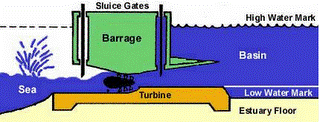





Published on Feb 14, 2025
The four main components of a tidal power generation plant will be subsequently discussed. These components (as shown in Figure 2) are a tidal basin, a tidal barrage, sluice gates, and the tidal turbines themselves.
The first component of a tidal power generation plant is a tidal basin, or estuary. Finding a proper site containing an estuary is essential for the successful operation of a tidal power generation plant. One must note that the estuary will not be man-made; rather, the tidal basin will be a geographical feature that is not easily

replicated. A suitable estuary is typically a large body of water that is almost entirely surrounded by land with a small opening to the sea. The amount of power that a tidal power generation plant can produce is proportional to the size of the estuary
The second component of a tidal power generation plant is the tidal barrage. This barrage looks like a wall that cuts off the estuary from the remainder of the sea. The bottom of the barrage sits on the sea floor, and the top of the barrage sits above the highest level that seawater can reach at high tide (Edinger 2000). The tidal barrage serves the purpose of cutting off seawater from water in the estuary so that water can be channeled through the wall in a beneficial manner for tidal power to be created.
The third component of tidal power generating plants is sluice gates. Basically defined, sluice gates are areas of the barrage where water can freely flow in and out of the estuary. These gates are not always open: rather, they are controlled by the power plant operators such that water flows in and out of the estuary in a favorable method to the tidal turbines. Sluice gates do not have a uniform location on the tidal barrage.
The fourth major component of tidal power generation plants is the tidal turbines themselves. These turbines are located within the tidal barrage, and sit near the bottom of the sea floor. The turbines are designed in the same manner as a steam turbine. The turbines lie between sluice gates located on both the estuary and seaside of the tidal barrage. When these gates are opened, water rushes through the turbines, spinning the blades and creating electricity.
Several different turbine configurations are possible. For example, the La Rance tidal plant near St Malo on the Brittany coast in France uses a bulb turbine (figure 5). In systems with a bulb turbine, water flows around the turbine, making access for maintenance difficult, as the water must be prevented from flowing past the turbine.
Rim turbines, such as the Straflo turbine used at Annapolis Royal in Nova Scotia, reduce these problems as the generator is mounted in the barrage, at right angles to the turbine blades. Unfortunately, it is difficult to regulate the performance of these turbines and it is unsuitable for use in pumping. Tubular turbines have been proposed for use in the Severn tidal project in the United Kingdom. In this configuration, the blades are connected to a long shaft and orientated at an angle so that the generator is sitting on top of the barrage.
| Are you interested in this topic.Then mail to us immediately to get the full report.
email :- contactv2@gmail.com |